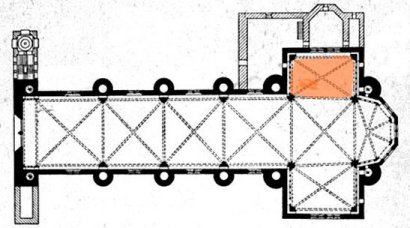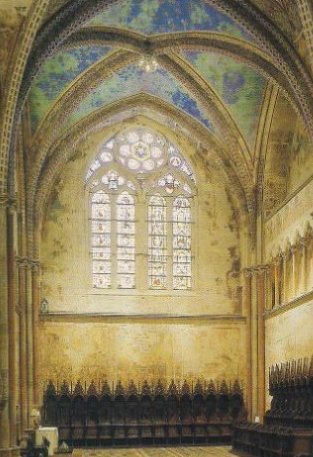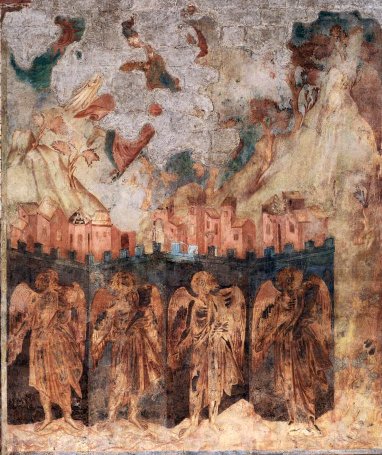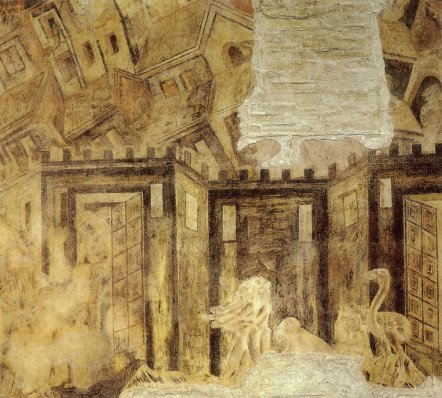|
Upper Church: South Transept |
|
|
S |
|
| The east wall
has one of the best-known frescoes: the crucifixion attributed to
Cimabue. Above are angels, and above that an almost completely destroyed
image of Christ in Glory. The crucifixion raises two questions. If this is where the Upper Church sequence begins, why start with a crucifixion? And why is there another crucifixion scene on the east wall of the North Transept? The sequence in the transepts and apse is concerned with the beginnings of the church, and in a very real sense the crucifixion marks this. And the scene in the North Transept does move the story along. The south transept image shows the living Christ; Mary Magdalene raises her hands in despair, while Christ entrusts his mother to John. In the north transept, Christ is dead, and Longinus is piercing Him with his spear. |
|
|
|
|
|
The south wall shows scenes of the last judgement. Again it is difficult to understand the context here. At the sides of the windows are images of angels, appropriate for this transept which is dedicated to St Michael. Below the window are three panels, shown below. Reading from left to right, they are: the adoration of the lamb by angels, elders, and the Evangelists (shown by their symbols), the angel of the sixth seal, and seven angels blowing trumpets after the opening of the seventh seal and the proclamation of the last judgement, with an angel burning incense on an altar. All three scenes are inspired by the Book of Revelation, Chapters 5 - 6. |
|
|
|
 |
|
Let's have a look at the second scene in more detail and see if we can find that context. |
|
|
|
|
|
Here's the relevant passage from Revelation Ch 6: And I beheld when he had opened the sixth seal, and, lo, there was a great earthquake; and the sun became black as sackcloth of hair, and the moon became as blood; And the stars of heaven fell unto the earth, even as a fig tree casteth her untimely figs, when she is shaken of a mighty wind. And the heaven departed as a scroll when it is rolled together; and every mountain and island were moved out of their places. And the kings of the earth, and the great men, and the rich men, and the chief captains, and the mighty men, and every bondman, and every free man, hid themselves in the dens and in the rocks of the mountains; And said to the mountains and rocks, Fall on us, and hide us from the face of him that sitteth on the throne, and from the wrath of the Lamb: For the great day of his wrath is come; and who shall be able to stand? And after these things I saw four angels standing on the four corners of the earth, holding the four winds of the earth, that the wind should not blow on the earth, nor on the sea, nor on any tree. And I saw another angel ascending from the east, having the seal of the living God: and he cried with a loud voice to the four angels, to whom it was given to hurt the earth and the sea, Saying, Hurt not the earth, neither the sea, nor the trees, till we have sealed the servants of our God in their foreheads. The angel of the sixth seal is above, though very badly damaged, and the angels of the four wings are below. Christ's death redeemed mankind, and ushered in a new age: so, it is claimed, will the apocalypse, when the virtuous will be saved and sinners damned. So why was this passage from Revelation so important to the Franciscans? We need to meet Joachim of Fiore, a twelfth century Franciscan mystic and confirmed apocalypticist. His vision is known as the Eternal Gospel, and the passage from Revelation above is at the heart of it. It is also at the heart of the entire scheme of frescoes of the Upper church. Joachim preached of three ages, closely allied to the Trinity: The Age of the Father, the Old Testament: an age of obedience to God’s rule. The Age of the Son, the New Testament: from the Birth of Christ until Joachim’s own time. The Age of the Holy Spirit, the impending age, when mankind would face the final conflict between good and evil and the righteous would be saved. For Joachim, and Bonaventure, this lay at the heart of Franciscan theology: for Francis himself was identified with that angel of the sixth seal who demanded that the destruction of the Earth should cease, until those worthy to be saved should be identified. This was to be the task of the Franciscans. Patrides and Wittreich, in The apocalypse in English Renaissance thought and literature, puts it this way: 'The angel of the sixth seal symbolically ‘seals’ the 144,000 of the faithful; St Francis and his disciples must save the church in the day of trial and lead it into the promised land. Joachim’s prophecy of the two new orders of spiritual men was applied to the two new mendicant orders of Friars Preacher and Friars Minor from about the middle of the century.' And here is Bonaventure: 'Now that this angel was indeed that messenger of God, beloved of Christ, our example and the world's wonder, Francis, the servant of God, we may with full assurance conclude.' (Life of St Francis, Prologue, II) On to the west wall
of the
transept. |
|
|
|
|
|
Upper Church page 1 Sacred places - art in context home page Art threads home page |
|






